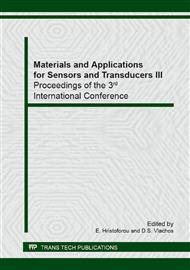[1]
DS Vlachos, DK Fragoulis, JN Avaritsiotis An adaptive neural network topology for degradation compensation of thin film tin oxide gas sensors, Sensors and Actuators B: Chemical, 45, 3, p.223–228, (1997)
DOI: 10.1016/s0925-4005(97)00309-2
Google Scholar
[2]
CA Papadopoulos, DS Vlachos, Effect of surface catalysts on the long-term performance of reactively sputtered tin and indium oxide gas sensors, Sensors and Actuators B: Chemical 42, 2, p.95–101, (1997)
DOI: 10.1016/s0925-4005(97)00190-1
Google Scholar
[3]
I. Giouroudi, A. Ktena and E. Hristoforou, Microstructural characterization of cylindrical Fe1-xNix thin films, J. Opt. Adv. Mat., 6, pp.45-50, (2004)
Google Scholar
[4]
E. Hristoforou, A. Ktena, Magnetostriction and magnetostrictive materials for sensing applications, J. Magn. Magn. Mater., 316, pp.372-378, (2007)
DOI: 10.1016/j.jmmm.2007.03.025
Google Scholar
[5]
E. Hristoforou, H. Chiriac, M. Neagu, A New Magnetic Field Sensor Based on Magnetostrictive Delay Lines, IEEE Trans. Instr. & Meas., 46, pp.632-635, (1997)
DOI: 10.1109/19.571942
Google Scholar
[6]
E. Hristoforou and D. Niarchos, Mechanical Sensors Based on Re-Entrant Flux Reversal, IEEE Trans. Mag., 28, pp.2190-2192, (1992)
DOI: 10.1109/20.179439
Google Scholar
[7]
P. D. Dimitropoulos, J. N. Avaritsiotis and E. Hristoforou, A novel micro-Fluxgate sensor based on the AMR effect of ferromagnetic film-resistors, Sensors and Actuators A, 107, pp.238-247, (2003)
DOI: 10.1016/s0924-4247(03)00378-9
Google Scholar
[8]
P. Dimitropoulos, J.N. Avaritsiotis, E. Hristoforou, Boosting the Performance of Miniature Fluxgates With Novel Signal Extraction Techniques, Sensors and Actuators A, 90, pp.56-72, (2001)
DOI: 10.1016/s0924-4247(01)00452-6
Google Scholar
[9]
C. Petridis, I Petrou, PD Dimitropoulos, E Hristoforou, Determining appropriate magnetic core properties for a new type of flux-gate like sensor, Sensor Letters, 5, pp.98-101, (2007)
DOI: 10.1166/sl.2007.072
Google Scholar
[10]
B. Dufay, S. Saez, C. Cordier, C. Dolabdjian, C. Dubuc, E. Hristoforou, S. Ubizskii, 2D hybrid yttrium iron garnet magnetic sensor noise characterization, IEEE Sensors Journal (12), art. 5873114, pp.3211-3215, (2011)
DOI: 10.1109/jsen.2011.2159372
Google Scholar
[11]
E. Hristoforou, H. Hauser and PD Dimitropoulos, On a New Principle of Smart Multi-Sensor Based on Magnetic Effects, IEEE Sensors, 6, pp.372-379, (2006)
DOI: 10.1109/jsen.2005.859781
Google Scholar
[12]
E. Hristoforou, New monolithic three dimensional field sensors with high sensitivity, J. Opt. Adv. Mat., 8, pp.1691-1697, (2006)
Google Scholar
[13]
C. Petridis, A. Ktena, E. Laskaris, PD Dimitropoulos, E Hristoforou, Ni-Fe thin film coated Cu wires for field sensing applications, Sensor Letters, 5, pp.93-97, (2007)
DOI: 10.1166/sl.2007.071
Google Scholar
[16]
CA Papadopoulos, DS Vlachos, Effect of surface catalysts on the long-term performance of reactively sputtered tin and indium oxide gas sensors, Sensors and Actuators B: Chemical, 42, 2, p.95–101, (1997)
DOI: 10.1016/s0925-4005(97)00190-1
Google Scholar
[17]
PD Skafidas, DS Vlachos, JN Avaritsiotis, Modelling and simulation of tin oxide based thick-film gas sensors using Monte Carlo techniques, - Sensors and Actuators B: Chemical, 19, 1–3, p.724–728, (1994)
DOI: 10.1016/0925-4005(93)01222-p
Google Scholar
[16]
I Petrou, P Skafidas, E Hristoforou, Electronic toll and road traffic monitoring system using 3-D field AMR sensors, Sensor Letters, 11, pp.91-95, (2013)
DOI: 10.1166/sl.2013.2787
Google Scholar
[17]
P.D. Dimitropoulos, G.I. Stamoulis, E. Hristoforou, A 3-d hybrid Jiles-Atherton/Stoner-Wohlfarth magnetic hysteresis model for inductive sensors and actuators, IEEE Sensors Journal, 6, pp.721-736, (2006)
DOI: 10.1109/jsen.2006.874454
Google Scholar
[18]
O. Bottauscio, M. Chiampi, G. Crotti, M. Zucca, Measurement accuracy in shielded magnetic fields, Journal of Magnetism and Magnetic Materials, Torino, (2004)
DOI: 10.1016/j.jmmm.2004.11.429
Google Scholar
[19]
Wan-Seop Kim, Yoon Bae Kim, Mun-Seog Kim, Kyu-Tae Kim, Yonuk Chong, Po Gyu Park, Young Gyun Kim, Optimizing the shielding effectiveness of a shielding cabinet via FEM simulation, Journal of Magnetism and Magnetic Materials, (2007)
DOI: 10.1016/j.jmmm.2007.03.123
Google Scholar
[20]
P. Sergeant, L. Dupre, J. Melkebeek, L. Vandenbossche, Magnetic field computation for optimized shielding of induction heaters, Journal of Computational and Applied Mathematics, (2003)
DOI: 10.1016/j.cam.2003.12.006
Google Scholar
[21]
Helmut Soltner, Ulrich Pabst, Michael Butzek, Michael Ohl, Tadeusz Kozielewski, Michael Monkenbusch, Don Sokol, LarryMaltin, Eric Lindgren, Stuart Koche, David Fugate, Design, construction, and performance of a magnetically shielded room for a neutron spin echo spectrometer, Nuclear Instruments and Methods in Physics Research A, (2011)
DOI: 10.1016/j.nima.2011.01.094
Google Scholar
[22]
M.V.K. Chari, S.J. Salon, Numerical Methods in Electromagnetism, Academic Press, San Diego, (2000)
Google Scholar


